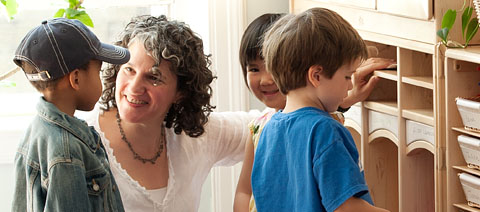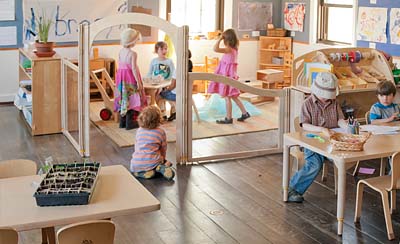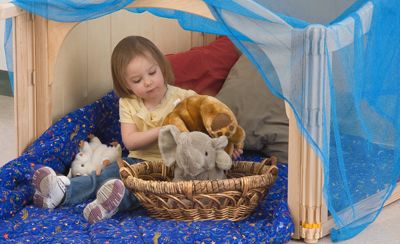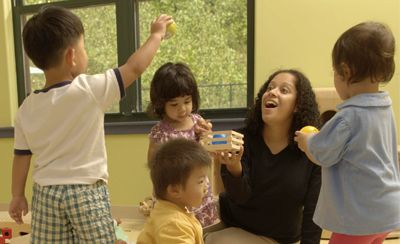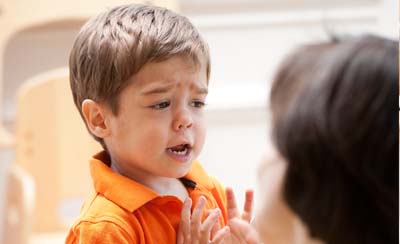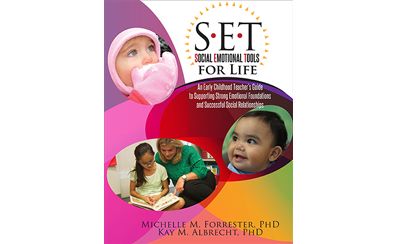Supporting Emotional and Social Development
Connections between the Classroom Environment and Thriving Children
|
June 2015
“There are three teachers of children: adults, other children, and their physical environment.” – Loris Malaguzzi
Imagine entering an early childhood classroom from a child’s perspective. The child is moving from the familiarity of her home into a totally different environment. Imagine the change in light and sound, all the different faces—it even smells different from the place where she woke up, in her own bed, just a few hours before.
As an early childhood educator, you have so much power to influence how children feelin your classroom! You know a classroom environment which helps children feel welcome, safe, and secure is critical to supporting ongoing emotional and social development. Children must first feel that their basic needs for safety, love, and belonging are met before they can take charge of their learning.
Maslow’s Hierarchy of Needs can help us understand why the classroom environment matters so much to children’s well-being and social success. The most basic level of need is confidence that physical needs will be met promptly and sensitively. Once that basic level is met, children must feel emotionally safe and supported. Finally, children need to feel like they belong–they need to feel welcomed and cherished. Only then is learning possible.
Establishing a predictable environment
You can start the day on the right note by first considering children’s transition from home to school. Start by mindfully designing your classroom to welcome children each morning. Provide cubbies where each child can store belongings and find them when they are needed. Near those cubbies, and in other places in the classroom, display images of the most important people in children’s lives, so those familiar faces can accompany them through their day. And, most importantly, take the time to greet each child with a warm welcome and a clean slate, leaving behind any challenges from the previous day and offering an unconditional fresh start.
The arrangement of your room can be almost as important in creating a welcoming environment as your warm and caring presence. You don’t need elaborate furniture or equipment to be purposeful in the ways you arrange and stock each individual activity area. Make the most of the space and supplies you have to support emotional and social development and to encourage learning.
One way to do this is to keep the classroom environment predictable, introducing change, challenge, and novelty in small doses. For example, arrange your library area with cozy areas for looking at books alone and larger chairs or benches for reading books with friends and with you. Keep the library furniture and arrangement basically the same from day to day, but spark children’s interest by introducing new themes and highlighting different books throughout the year.
Make sure the physical environment of your classroom meets children where they are. Provide enough toys and materials (offering duplicates if necessary), so children don’t have to wait longer for a turn than their age and developmental stage allow. Children can only practice the important skills of waiting, sharing, and turn-taking when they trust that their turn will come before they are out of patience!
You can help set children up for successful transitions from one activity to the next by providing cues about how to maintain order. Label shelves and storage areas, and use furniture to divide play spaces (for example, using bookshelves to create a special place for dramatic play, or easy-to-clean table mats to delineate where to work on your very own art project in the art area).
Furniture can delineate boundaries between areas.
Making play a regular and predictable part of your daily schedule is another way you can support emotional development and create opportunities to support social development. Offer plenty of uninterrupted, child-directed play, apart from teacher-led instruction time. Children are the most creative and open to new experiences when they are playing. Enhance this time by providing interesting and engaging invitations to play, sparking play ideas children might not have thought of before. (For example, children will be delighted to find all the fire trucks surrounding a castle in the block area, giving them the opportunity to wonder and explore what is happening and what they should do!) You can minimize conflicts and maximize playtime by using the classroom layout to offer options for all kinds of play: alone, with friends (groups of 2 to 5 children usually work best), or with a teacher.
As you know, early childhood classrooms are naturally boisterous places, full of energy, activity, and talk. Strive for a balance between opportunities for active, physical play and calming, quiet activities that help children take a break. Sometimes, children may need to move their bodies to release energy—dancing, stretching, and unstructured outdoor play, are great ways to “get the wiggles out” and refocus. Other times, children may need a refuge from all the activity, especially during moments of intense emotion. Provide adequate space for regrouping, alone, with a friend, or with you. This area should be separated from the busyness of the classroom, giving children the opportunity to step away from other activities when they need a quiet moment.
A place to regroup.
Supporting Emotional Development
The number and placement of teachers and caregivers are important components to a supportive classroom environment. It’s hard for children to wait for a turn with a favorite toy or activity—it’s even harder for them to wait for attention from you! Small, age-appropriate group sizes and maximum adult-to-child ratios are vital. While funding is often a concern, adequate staffing is crucial to supporting the emotional and social development of young children. Focused, attentive, one-on-one time builds relationships, and helps children to feel safe, secure, and special, creating the pathway for learning.
While your program may not be able to add extra staff, you can plan your day so that children don’t have to wait too long for your attention. Limit how often you ask children to participate in whole-class activities. Instead, create mindfully matched small groups (two to five children) for instruction. Let other children create their own play groups and choose activity areas and materials to support their play ideas. Be aware that some children will need more of your attention and time during the day, especially if they are coping with other stressors outside of school (a parent traveling, a new tooth, or the arrival of a new baby, for example).
Take care to stay in sight, arranging furniture so children can easily find you whenever they need to check in with you for reassurance or help. Sometimes, just a warm smile and a gesture of encouragement (a nod of your head or a thumbs up) is enough to calm a worry or ease frustration. A classroom laid out this way also makes it easier for you, the teacher, to observe children as they work and play. As you make observations, get to know the children you teach, and support them as they build friendships with each other. Be ready to make modifications to your classroom layout, your daily schedule, and the way children are grouped during work and play time. Encourage willing support-staff and volunteers to help with routine classroom tasks, like sorting papers or restocking the art center, so that you can spend more of your time and energy interacting with children to build strong relationships.
Quality interaction builds strong relationships.
Modeling Healthy Emotional Expression
The most crucial part of an emotionally supportive classroom is the teacher. Your approach, attitude, and skills set the tone. Without any special tools, you can make your classroom a place where children can grow and thrive—socially, emotionally, and academically.
Socially and emotionally supportive teachers put relationships first—they see children as individuals and take the time to get to know each child by spending their valuable time as an observer of play, and a regular play partner. They support children as they build social skills by allying with them to solve problems when it’s too hard to do it alone. They scaffold play: helping children to build on their ideas, practice communication and social skills they already have, and helping them try new ideas when what they are doing isn’t working. Having friends and being a friend isn’t always easy—children need your encouragement and support to build positive relationships with each other.
Modeling healthy emotional expression is one way teachers like you can support children’s developing emotional skills. Children learn so much when they hear you label and express your feelings—authentically and often. When you say, “I’m so disappointed it’s raining today! I was really hoping to go on a nature walk,” children hear that strong emotions are normal, natural, and manageable. You can build emotional skills by naming feelings for children, too: “That is a loud squeal! You sound thrilled!”
Learning how to discuss emotions is an important life skill.
One more thing you can do to build an emotionally supportive classroom is to incorporate learning about feelings into your curriculum. The National Scientific Council on the Developing Child put it this way: “All early childhood programs must balance their focus on content and literacy skills with significant focus on emotional and social development” (2004). Expand your feelings language. Post a feelings chart, and encourage children to talk about which face matches how they feel during morning meetings or when strong emotions threaten to overwhelm them. The differences between being angry and being irritated are important! Learning the words for a wide variety of emotions and connecting that language to the way your body feels when you experience them are great examples of emotional curriculum during the early childhood period. Include books that discuss emotions and ways to manage them, as well as books that talk about developmental milestones and challenges common to many children (losing a tooth, or moving to a new house, for example). Treat emotional and social learning with the same intentional care you offer mathematics, literacy, and science, knowing that the skills young children learn in your classroom will stay with them their entire lives!
Your classroom environment can play a critical role in helping children develop social and emotional skills. Designing a welcoming, predictable, and developmentally appropriate environment; prioritizing play in your daily routine; arranging your classroom so children can find and connect with you and with each other during the day; and integrating learning about emotions into your curriculum can help children develop skills that lead to success in school, at home, and in the wider world.

